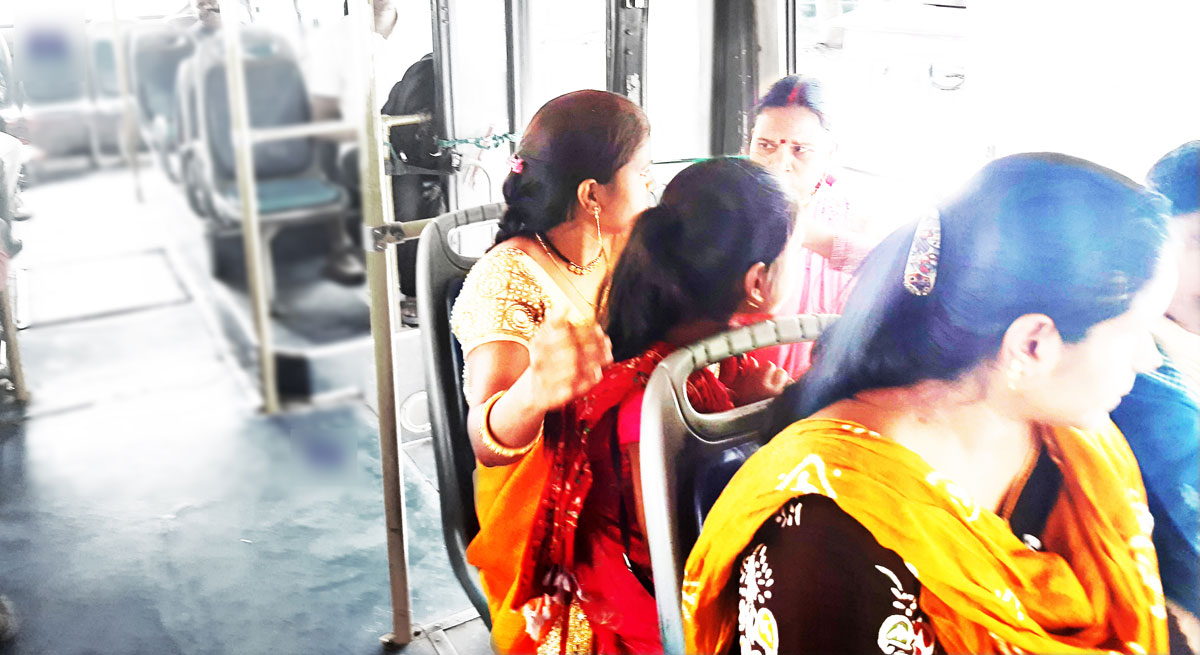A lot of debate is going around Delhi CM ArvindKejriwal’s announcement about free bus commute for women. Our CM was quoted saying “Pink Ticket… I send heartiest greetings on BhaiDooj to all the sisters of the Delhi family. May you stay safe and progress… The country can progress only when women progress…” but is making the bus ticket free for women actually progress? Or are we regressing back to a time where we want women to be dependent once again? And why aren’t we talking about the economic state and development of women now that we’re making a ticket that costs Rs. 10 or Rs. 15 free? The fact that the ticket is pink and clearly distinguishes as ‘different’ is also problematic considering 30% of bus riders are women.
In the wake of this news, let’s have a look at some existing transport services for women around the globe.
The ‘women only’ coaches in Delhi metro
In 2013, union minister Maneka Gandhi proposed this idea to allot a metro coach entirely to women. Maneka Gandhi came up with this idea because of existing examples of women-only metro coaches in other countries. This move was rolled-in to curtail sexual and harassment issues that women often have to go through in co-ed metro coaches.
Metro in Japan adopted women-only cars
To curb with sexual offences in the co-ed metro cars, Tokyo metro unfurled the women-only metro cars for the morning rush hour. This move provided female students and workers a sense of safety while using public conveyance.
Women-only minibus in Nepal
The women-only minibus service was established by Nepali Minibus Entrepreneurs Association in Nepal’s capital Kathmandu. This service was started considering the inconveniences faced by women commuters especially during and after office hours.
This service was initially a pilot project but it turned to become permanent because of its fine review. In the beginning, only three buses were used for operating this service but the number of buses was multiplied with time. This initiative was widely appreciated by women in Nepal which is obviously apparent from its subsistence.
‘Paxi’ or Pink taxi in Pakistan
In 2014, Authorities in Pakistan launched a minibus service exclusively for women travelling between the twin cities of Rawalpindi and Islamabad. These mini-buses were named ‘paxi’ which is a syllogism for pink taxi. Later on, female drivers were enrolled for these taxis. These mini-buses were equipped with fire-extinguishers and first-aid kit for emergency purposes.
Women-only subway cars in Egypt
Commenced in 1987, this service is one of the oldest transport service declared for women. According to a report by U.N., about 99% of women in Cairo have faced sexual harassment. This move was much needed in a place where sexual molestation of women is very high. This service had implementation and functioning issues as it was reported that men were often seen boarding these subway cars.
Women-only subway cars in Brazil
The women-only cars in metro are a much prevalent idea in many countries. The first women-only cars in Brazil were introduced to Sao Paulo back in 1995, but were discontinued due to complaints from married couples, and Egypt’s law of equality among the citizens. This service was again introduced on international women’s day in Rio De Janeiro in 2006 due to rising sexual offences against women.
Mumbai’s local trains have ‘women-only’ coaches
Mumbai’s popular public transport i.e., local train, have two coaches entirely reserved for women. The coach class I-L and class II-L are allotted solely to women. This move was made to give a sense of security to women travelling in public transport, especially at late hours.
Female reserved carriages and pink taxis in Mexico
In 2000, carriages reserved only for females were introduced in the metro of Mexico. The first few cars were dedicated entirely for women and children. This paved the way for pink taxis in Mexico that had female drivers, alarm button and a make-up kit.
Women-only carriages in Thailand’s train
The State Railway of Thailand introduced women-only carriages in 2014 in three of its most important routes. This was done after the rape of a 13-year old girl on the train.
Iran’s metro subway has carriages only for women
Since long, the Iranian capital Tehran has metro subways allotted solely to women passengers. This norm also spread to other public transport in Iran. In 2006, gender divided bus services were commenced in Tehran wherewomen could have their own buses with female drivers.
Tracing the footsteps: the initial women-only carriages
‘Ladies Only’ compartments were first introduced in 1874 in United Kingdom by the Metropolitan Railway. However, these compartments had a very low turnout so the practice soon became a service on request, rather than all the time. With time, this policy was completely abolished.
This policy was taken and followed in the coming years by other nations.
Delhi’s bid to make public transport safer for women cannot be achieved by making tickets free. It has to come with the understanding that men are using these platforms to grope, harass and molest women and that is why they feel unsafe, not because they think the ticket price is expensive. Yes, free tickets might encourage more women to ride buses but the problem of accessibility and rowdiness will prevail and will end up targeting even more women now. What do you think about this scheme by the Government? Do you think we can channel it in a way that makes taking the bus safer for women? Or does it encourage men to think that women get special advantages?
https://www.youtube.com/watch?v=hzRFU0WY76w
https://womenintheworld.com/wp-content/uploads/2015/04/img_28751.jpg





